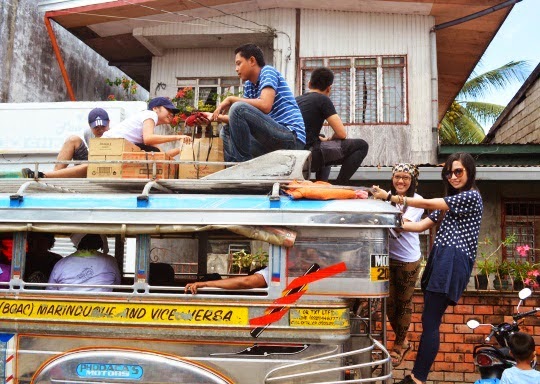One of the best things about Marinduque is that it offers a bit of everything ‒ from its pristine
islets, the raw and unspoiled beaches, the green-fanged outcrop of mountains, roaring
falls like skeins of white lawns, and even yet-to-be-discovered caves. And not to mention, it’s
geographically positioned at the heart of the archipelago from where the
official center marker is located, the Luzon Datum of 1911. Odds on our side, we had this awesome chance of setting foot at this deemed center of the
Philippines, which pretty well served as the highlight of our weekend
Marinduque sojourn.
The journey itself was a test, to begin with. Taking aside the climb
proper, the ride to the jump-off was something that should not at all be underestimated.
From where we stayed at Bancuangan Sta. Cruz, we drove to Mogpog town
proper through a free lift courtesy of our hospitable hosts luckily saving us from the initial hassle of commuting. However, things started to go against us since then; the
stars were not our friends as soon as after dropping
ourselves off the public market. We walked and searched for a jeepney to Hinanggayon, the barangay where the mountain’s jump-off
point is located. Little did we know that it was their fiesta causing the lone jeepney chartered to travel directly to the jump-off unavailable that day.
We've got no other choice but to find an alternate plan. After few exchanges with the locals in search for the alternate means to reach the jumpoff, we learned
that there is another jeepney that would pass near the jump-off point. In no time, we grabbed the opportunity fingers-crossed
for a positive outcome. We opted to ride topload instead of
having cushion-filled and safe seats inside the jeepney as a courtesy to the regular and local passengers. And we did not fail to
get the crazy ride we hoped for. Usually, those built-in railings at the topload are intended for carrying
extra baggage, goods, and even people for transport to remote areas to
maximize the efficiency of the trip. But more to that, it also showcases the
natural inventiveness and creativity of the locals, which is worthy to be
recognized as a means of tourist attraction, especially for travelers who seek spiced-up adventures.
However,
the supposed short jeepney ride was extended for a great deal of time as there were lots of
stopovers throughout the trip to give way for picking up goods and commodities
such as sacks of rice, lumbers, food items, among others, usually from locals who opt not to drain themselves from the tiring ride by just ordering and making arrangements
with the driver to save time and energy. Unfortunately, this move is inversely proportional
to our comfort and advantage as the amount of space for us over the top load area went cramped
even more. A couple of more steps eventually left us with a very tiny room for
ourselves, further causing us to suffer from
every onslaught of bumps and humps, given that it was a rough ride during
majority of the ride.
It was
almost noontime when we reached the jump-off point and the sun was already at
its cruelest state. This mere thought was as deadly as it sounds. With a
little over a liter of water, a heavy backpack, and a thirsty soul, we started
the trek, and then the real walk unfolded before eventually taking the
death-defying march to the peak. All those immeasurable grains of sweats, blurry
eyes, gasping breaths, aching knees and more, happened under the heat of the sun.
And
just in time, we found ourselves walking those 267-step stairs that before we realized
we were there, I had my feet step at that recognized center of the Ph marker. It
took me minutes to regain my senses in awe of the unhindered view up there, celebrating the grandiose beauty up there, trying to capture its essence
in lenses. The whole trip was draining but the mere thought of me
standing there, at the "center of the Philippines", was no less
than priceless.















